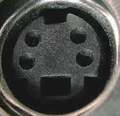Apple Desktop Bus (or ADB) is a bit-serial computer bus for connecting low-speed devices to computers. It was subsequently used on all Apple Macintosh machines starting with the Macintosh II and Macintosh SE, before it was replaced by USB. No machines being built today use ADB for device interconnection, but Powerbooks and iBooks still use ADB to interface with the builtin keyboard and trackpad.
Apple ADB bus uses small 4 pin connector and the maximum length of the serial bus is 5 meters. ADB bus can supply total of 200 mA of +5V power to the devices connected to it. If the devices draw more current than allowed, the overcurrent protection will shut down the power feed. Devices which connect to the ADB contain their own micro-processors, which handle both device routines and the ADB interface. There are 16 possible device locations available on the ADB. Each device can maintain up to four variable-size registers which may be read or written from the device over the ADB network using four available control commands. Physically, ADB cables are identical to S-Video cables.
| Pin | Name | Description |
|---|---|---|
| 1 | ADB | Apple Desktop Bus |
| 2 | PSW | Power Switch |
| 3 | +5V | Power +5V |
| 4 | GND | Ground |
Note : Power +5V is 200mA (500mA?), each peripheral should use 100mA max. Pin 2 is used only in the Macintosh II family, Quadra 700 and 900, and PowerBook series. Unused on all other models.
Signals
ADB (Apple Desktop Bus)
Macintosh bidirectional data bus.
PSW (Power Switch)
Switch to startup, reset or interrupt the computer.
All traffic on the bus is driven by the host computer, which sends out commands to read or write data: devices are not allowed to use the bus unless the computer first requests it. These requests took the form of single-byte strings. The upper four bits contained the address, the id of one device on the chain, allowing for up to 16 devices on a single bus. The next two bits specified one of four commands, and the final two bits indicated one of four registers.



 правильная
правильная с ошибками
с ошибками